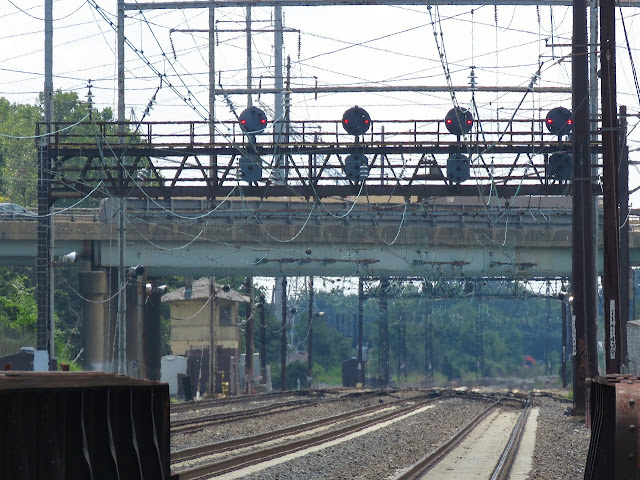The Pennsylvania Railroad's electrification system was not a monolithic project that was built in one go. From start to finish the project took a total of 24 years, although the majority of this took place in the 11 year span between 1928 and 1939. While most people can easily recognize the 1915 prototype electrification to Paoli with its distinctive round poles and near exclusive use of cable cross spans, as well as the later 1930's style with the H beams topped by high voltage transmission lines, fewer people are aware of an intermediate style of electrification constructed in 1928 between Philadelphia and Wilmington. This first segment of the PRR "long distance" electrification plan was centered on the Lamokin frequency converter plant located at the junction of the Chester Creek branch with the Philadelphia to Washington main line. The plant provided a majority of the 25hz generation capacity until 1932 and then quietly remained in operation for the next 90+ years. During the summer of 2020 I ventured out to the Lamokin area to check out the converter plant as well as the remains of the old commuter station and interlocking. You can find the full set of photos here ( mirror ).
The converter plant is apparently owned(?)/operated by the local electric power concern Exelon (formerly Peco, formerly The Philadelphia Electric Company). The large building hints at the heavy industrial nature of early power generation with three large 16MW dynamic state motor generators changing 60hz grid power into 48MW of 25hz railroad power. 25hz was an early AC electrification standard that was particularly well suited to series wound AC motors in industrial applications that could be controlled without the benefit of a variable frequency drive. In addition to its imposing structure, the building emits a distinctive whooshing sound which attests to the quality of the electricity being produced. Despite being less efficient and more maintenance intensive than solid state converters, the motor-generators are highly resistant to current and voltage fluctuations as well as cyberattacks that have been known to disable solid state frequency converters. For this and other reasons, Amtrak recently completely rebuilt each of the converters at the Lamokin plant for use into the foreseeable future.
In addition to the Wilmington Line, the PRR also indented the Lamokin plant to serve the electrified suburban line to West Chester that was being implemented at the same time with plans (later cancelled) to send the current all the way to the Main Line at Paoli. While the Chester Creek branch physically connected the Main Line to the West Chester branch, the lack of any electrification need prompted the PRR to construct its own overland 25hz transmission circuit from Lamokin to the substation at Lenni. This line also remains in operation at the present day.
The outdoor switchyard looks a little messy as it was designed to use 7 25hz step up transformers feeding Amtrak's 138kv transmission system. The third bushing is for a center tapped grounding resistor and is not an indication of more typical 3 phase AC current. The converter was originally fed via burried 13.3kv feeders from the former Demaware County Power Plant. While that power station has since been converted into office space, a utility substation on the property is the likely source of the grid connection. Logically separate from the Lamokin Step-Up, Lamokin Substation #11 located on the south and east sides of the yard has three of its own 138kv step down transformers for the 12kv overhead catenary as well as the related section switching.
The Philadelphia to Wilmington electrification projects saw the first deployment of the PRR's 132kv (later 138kv) transmission network. The previously electrified Paoli and West Chester lines used a 44kv split phase transmission system with a 22kv maximum potential from each wire to ground. The contemporary New Haven and later Reading electrification systems used a similar approach, although neither would prove particularly suited to main line locomotive hauled operations with the New Haven suffering chronic power shortages in its later years. The PRR's independent 132kv 25hz transmission grid would ultimately be able to send power between any two points between New York, Washington and Harrisburg. In addition to the 132kv circuit to Lenni, Lamokin would also provide power to two circuits on the main line. The lightly built lattice and round pole structures on the Wilmington portion would quickly be replaced by beefy H beams on the West Chester branch that in turn set another standard that would last up to the present day.


















